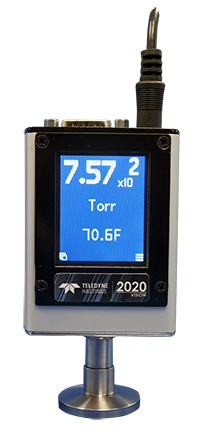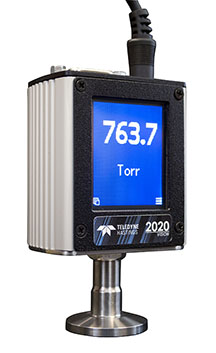Wide range vacuum gauges are measurement instruments that use a combination of technologies to cover from atmosphere to ultra-high vacuum. Examples of these technologies include a Pirani gauge, piezo sensors, or hot and cold cathodes. A wide range gauge would use 2-3 of these technologies that couldn’t be covered by just one of them alone.
As an example, Pirani vacuum gauges measure a low to medium range vacuum and can be paired with either a piezo gauge or an ionization gauge to measure either atmospheric pressure or ultra-high vacuum depending on the purpose of the wide range gauge. This helps provide a compact solution to your vacuum application by providing a single port pressure measurement that is directly integrated into your system. There is a huge variety of vacuum gauge technologies used and this page will focus on some of the common vacuum gauge technologies and their many novel features that are used in wide range vacuum gauges.

A Pirani gauge is an indirect vacuum gauge that measures the pressure-dependent thermal conductivity of the gas in a vacuum using a heated element, such as a wire or thin-film membrane. The heated element is part of a resistance bridge. The temperature, and thus the resistance of the heated element in the vacuum changes as the pressure changes. By measuring the electrical behavior of the bridge, the pressure in the vacuum can be determined.
As mentioned above, Pirani vacuum gauges measure from low to medium range vacuum. This is typically defined below 1 Torr and throughout the mTorr range. The HVG-2020B pairs our Pirani gauge technology with a piezo sensor to provide a compact solution to measure a wide range from Atmospheric Pressure to medium vacuum with a single port pressure measurement. The fast, accurate readings of the HVG-2020B allows for better process control in the vacuum system they are directly integrated into. The accurate readings at both atmospheric pressure and in the mTorr range provides comprehensive diagnostics over the wide range during the process.
Some of the many novel features of the HVG-2020B is the optional color touchscreen display and the push-button calibration procedure to easily zero your HVG-2020B. The touchscreen display allows you to monitor your measurements and control your vacuum gauge such as changing the display mode to a pressure versus time graph or by using the set-point controls to maintain your vacuum between the high and low set-points. The
HVG-2020B also allows you to communicate with LabView Drivers, logarithmic output, linear output, and digital communications when there is no display.

Piezoelectric vacuum gauges are a direct vacuum (or pressure) instrument used to measure vacuum/pressure. In a piezoelectric gauge, the sensor contains piezoelectric material whose electrical properties, such as resistance, change as stress is applied. A piezoelectric gauge measures the mechanical stress imparted on a thin membrane which in turn changes the stress on the piezoelectric material thus causing a change in electrical output signal. The electrical output signal corresponds to the pressure. The HVG-2020A uses this electrical signal to produce a reading on the display or to provide a linear output. The
HVG-2020A also allows you to communicate with LabView Drivers, linear output, and digital communications when there is no display.
The HVG-2020A and HVG-2020B uses our knowledge of piezo sensors to measure rough vacuum to atmospheric pressure or by pairing with a Pirani gauge to create a wide range solution that measures below the 1 Torr range.
Cold Cathode Gauge
Cold cathode vacuum gauges are an indirect vacuum gauge used to measure pressure in a vacuum system. The cold cathode gauge is a type of ionization gauge in which a crossed high voltage electric field and a magnetic field set up a discharge. The resulting positive ion current is proportional to the pressure in the vacuum system.
Cold cathode gauges are used to measure from high vacuum to ultra-high vacuum. This can be as low 1 X 10-10
Torr. By pairing cold cathode vacuum gauges with a Pirani gauge, you have a wide range vacuum gauge that provides single port measurement from medium to ultra-high vacuum. This is especially helpful for applications which require minimal air contaminants. In some cases, a wide range vacuum gauge can be further expanded upon by adding a 3rd technology. This would provide a compact solution that measures this wide range from atmospheric pressure to ultra-high vacuum. While this would provide a single port pressure measurement solution, there are typically other vacuum gauges in the system to confirm the readings on the wide range vacuum gauge.
The HVG-2020 has many novel features to provide a superior user experience.

